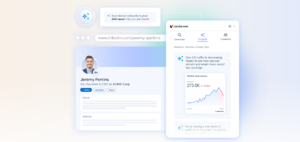by Sam Martin-Ross is UK Managing Director of digital marketing agency, Eskimoz
Customer relationship management (CRM) software is ubiquitous throughout nearly every type of business, and for good reason. Simply put, it’s a technology that allows companies to easily manage interactions with existing and potential customers, and nurture leads through the purchasing cycle.
Being vital to several core operational elements of a business, including sales, marketing and customer experience, CRMs not only help deliver a personalised experience to your customers, but can guide sales and marketing activity through the data-backed insights they provide
Currently, around 92% of companies use databases to store information on a customer or a prospect, but any database or CRM software is only as good as the data stored within. Below, we explore some of the key stumbling blocks around data that prevents organisations from realising a return on investment on their CRM platform.
Data quality
With the average CRM database holding hundreds, if not thousands, of individual customer records, it’s natural that over time these data points will change or become obsolete. Perhaps a B2B prospect has moved company, or a previously loyal customer to your brand has switched email addresses and is no longer receiving your marketing communications.
Salesforce suggests that up to 70% of data held in a CRM “goes bad”, or becomes obsolete, each and every year. This percentage translates directly into ineffective marketing and sales strategies that are essentially built on bad foundations, resulting in wasted time for organisations. Research suggests that 27.3% of seller time per salesperson can be lost through outdated prospect data, impacting not only the
bottom line, but also the return on investment received from often-expensive CRM software.
It is therefore essential to conduct regular audits of the data stored within your CRM, ensuring it is consistent, up-to-date and formatted correctly.
Focusing on the wrong information
Marketers love data. It helps inform strategic campaigns, assists with developing useful audience segments, and provides insight into the efficacy of previous sales and marketing activities. However, when it comes to your CRM, trying to collect as much data as possible on every prospect or lead could actually be doing more harm than good.
Many businesses make the mistake of asking their customers or leads for unnecessary information. For example, the most important piece of information for a B2B business is the email address of a lead. It’s straightforward to then use the email domain to look up all the company information you might need, without putting a potential prospect off by asking for too much of their data. Automations can easily
be set up with tools like Zapier, Clearbit or Apollo that can find this information for you.
For retail businesses, it may be tempting to require people to sign up with an account before purchase, but this can also backfire. Allow purchasing without signing up, and your CRM records should still be able to store relevant information based on their email. Similarly, while it may seem useful to personalise marketing communications based on interests, gender and similar preferences, this isn’t as effective as simply using their browsing and purchasing data, and avoids making false assumptions about your customers.
Before filling your CRM with extraneous data points, it’s important to really think about which data is adding value to your marketing, sales and customer service activities before asking customers and prospects to provide it.
Using the right data
The right information is necessary to build and launch effective campaigns and marketing strategies, and obtaining the correct metrics to measure their success. One particularly useful metric is lifetime customer value – once this is established, it allows you to see how much you should be willing to spend per new customer, and this will guide your marketing activities. Setting up referrals to track this is one of the most cost-effective acquisition channels
Focusing on lifetime value is often more insightful than cost-per-acquisition, as most businesses will be willing to spend more on acquiring new customers, and this value is ultimately decided by the lifetime value of the customer. Retention also plays into this in a major way. Ultimately, retention is more important than acquisition. By getting your customers to return time and time again, you are effectively increasing
the lifetime value of each customer on average, which in turn enables you to spend more on acquisition and generate new custom is a cost-effective way.
As we’ve touched on above, a far more reliable way to do this with your available data is to carefully look at the purchasing and browsing history of a particular customer, and serve them ads, offers and other marketing communications based on this. Let’s say that a customer regularly spends £100 on shirts. Using this information, we can send them a promotional offer through email with a discount code applied to an order of shirts over £150. This tactic can be easily rolled out across many customers, increasing their average order value using the data you already have on them.
Final thoughts
The right CRM software combined with properly maintained data is a powerful tool for any business, but maximising the return on your investment means developing a strategic view of your CRM platform. To do this, it’s vital to set clear goals for the software, and decide on the underlying business objectives. This will enable you to identify the most pertinent data points needed to achieve these goals, and help you use the data at your disposal to reach your sales and marketing objectives.






